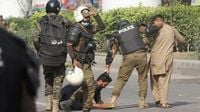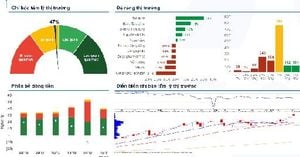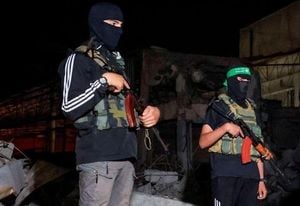In a series of dramatic and violent events across Pakistan’s Punjab province, the government has launched its largest-ever crackdown on the far-right Islamist group Tehreek-i-Labbaik Pakistan (TLP), raising fears of a broader unrest reminiscent of the country’s tumultuous past. Over the past week, Pakistani authorities have moved with unprecedented force to neutralize what they describe as a mounting threat from the TLP—a group with a history of violent protests, attacks on religious minorities, and a growing political influence in the nation’s heartland.
According to Dawn, the catalyst for this sweeping operation was a confrontation in the city of Muridke, where police sought to disperse encamped TLP protesters. The aftermath has seen more than 2,700 arrests across Punjab, with 251 in Lahore, 178 in Sheikhpura, 190 in Mandi Bahauddin, 155 in Rawalpindi, 143 in Faisalabad, 135 in Gujranwala, 128 in Sialkot, and 25 in Vehari. In just 48 hours, police rounded up hundreds of activists, including several senior leaders, as the number of registered criminal cases against the outfit soared to 72—39 of which were filed in Lahore alone.
The crackdown comes amidst a backdrop of escalating violence attributed to the TLP. Punjab police officials revealed in high-level meetings that the group has been linked to 25 attacks on Christian and Ahmadiyya places of worship over the past three years. These attacks, characterized by arson, vandalism, and deadly assaults, have left a trail of destruction, with several fatalities and dozens injured. Authorities argue that the TLP’s repeated resort to violence and its ability to mobilize large crowds pose a significant risk to law enforcement and Pakistan’s non-Muslim communities.
As reported by India Today, the military’s approach this time has been unyielding. Armoured personnel carriers rolled through crowds of TLP supporters marching toward Islamabad, with security forces opening fire and killing dozens of people. The operation is being described as the closest Pakistan has come to the scale of China’s infamous Tiananmen Square crackdown in 1989. Internet blackouts were swiftly imposed in Lahore, Islamabad, and Rawalpindi to contain the unrest and stymie the group’s ability to coordinate further protests.
At the center of the storm is TLP chief Saad Hussain Rizvi. On October 14, Rizvi was reportedly shot and wounded while leading street protests; his fate remains uncertain, with conflicting accounts of his whereabouts. Lahore Deputy Inspector General Faisal Kamran stated that Rizvi had fled during the Muridke police operation, but authorities claim to be closing in on his location. Meanwhile, a money laundering probe has been launched against Rizvi after law enforcers discovered large sums of cash during a raid on his Lahore residence.
The government’s hardline stance is a marked departure from previous approaches. Military chief and de facto ruler Field Marshal Asim Munir has declared this a transition to what he calls a “hard state,” signaling a readiness to use force where his predecessor, General Bajwa, favored negotiation. “It was the last chance for the state and its institutions to deal with the TLP with an iron hand,” a senior police official told Dawn, reflecting a consensus among top officials that the group must be restricted to political activities and prevented from using street power to “blackmail the state.”
The TLP’s rise is particularly alarming because it has rapidly evolved from a fringe movement to a formidable political force. In the 2024 elections, the party secured over 2.9 million votes, making it Pakistan’s fourth largest political party, as highlighted by India Today. Punjab, the epicenter of the current crackdown, is not just the country’s most populous region—accounting for over 53% of the population—but also its economic engine, generating more than 55% of national GDP and over 70% of tax revenue. While insurgencies have long plagued Pakistan’s border provinces, Punjab has historically remained insulated from such turmoil. The TLP’s growth suggests that radicalization is no longer confined to the periphery.
The government’s heavy-handed response has revived memories of the 2007 Lal Masjid (Red Mosque) operation in Islamabad, where a military assault on radical clerics sparked a deadly insurgency that continues to haunt Pakistan. The parallels are not lost on analysts and the public alike. As India Today notes, the Lal Masjid episode triggered the rise of the Tehreek-e-Taliban Pakistan (TTP), which would go on to become the state’s most lethal internal threat, responsible for tens of thousands of deaths in the years that followed.
Pakistan’s current predicament is compounded by a fragile economy teetering on the edge of collapse, kept afloat by a $7 billion International Monetary Fund loan. The military is stretched thin, facing not only unrest in Punjab but also insurgencies in Khyber Pakhtunkhwa and Baluchistan, border tensions with India, and a hostile Afghan Taliban along the Durand Line. The May 20 massacre of 26 Indian tourists in Pahalgam and the subsequent loss of Pakistani military assets have further destabilized the region, leaving Field Marshal Munir in a far more precarious position than his predecessors.
International developments have added yet another layer of complexity. On October 14, as the crackdown unfolded at home, Pakistani Prime Minister Shehbaz Sharif was in Sharm el-Sheikh, Egypt, endorsing the Trump-brokered 20-point Gaza Peace Plan. Pakistan’s support for the plan, and speculation about potential diplomatic ties with Israel or even the deployment of Pakistani troops to Gaza, has inflamed passions among the TLP’s base, which has long championed the Palestinian cause.
The government’s challenge is formidable: how to contain the TLP’s street power without triggering a wider insurgency, and how to navigate international pressures without alienating a radicalized domestic audience. As the crackdown continues, Pakistan stands at a crossroads. The memory of Lal Masjid looms large, serving as a cautionary tale of how forceful suppression of religious movements can spiral into prolonged conflict. Yet, with the TLP’s record of violence and its growing political clout, many officials believe that decisive action is the only way to prevent further chaos.
For now, Punjab remains under tight security, with police and military patrols visible in major cities. The fate of Saad Rizvi and the TLP’s leadership remains uncertain, as does the long-term impact of the government’s actions. What is clear is that Pakistan’s core province is no longer immune to the country’s cycles of violence and radicalization—a reality that will shape the nation’s politics and security for years to come.





